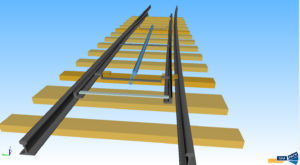Research on self-adjusting railway track switch could reduce both journey delays and maintenance costs
This research was conducted by Dr Saikat Dutta, Professor Roger Dixon and colleagues from Loughborough University.
The railways have been through major innovations in the past two centuries. Despite frequent ground-breaking innovations, regular commuters are more commonly concerned about frequent delays. These disruptions are often caused by switch failures – failures which accounted for 18% of the total delay in minutes in the UK between 2008 – 2011.

Photo by Brett Sayles from Pexels
Railway switches are the mechanisms installed on the tracks, mainly on railway junctions where they branch off, enabling the change of lines or routes of the trains. Failure in the switch systems causes significant delays due to the safety-critical nature of the track switch.
Traditional switch actuators run in open loop configuration and don’t have any self-adjusting capabilities within the control unit. What this means is that if the actuator fails, the switch either doesn’t operate or doesn’t move the rails correctly. The only way to fix this is to go to the location to apply the appropriate maintenance.
Our research proposes a new algorithm to control the movement of the switch using a closed loop feedback controller and a self-adjusting algorithm which is able to accommodate misalignment in the switch layout within a predefined acceptable range.
Our research presents two new concepts in modelling and controlling the switch system.
Firstly, the modelling approach is the first time when a full switch system is modelled considering the three aspects of modelling:
- Multibody simulation (using Simpack)
- Controller (Simulink),
- Rail bending (Finite Element Analysis in Abaqus).

Simulation image of track switchThe newly developed high fidelity dynamic model of the track switch is capable of predicting the movement of the switch actuator and the bending of the rails during the switching action. The experimental results from a working switch system validate the modelling data and this model is used to design the control algorithm and check its functionality.
Secondly, in the operating railway environment, it is common that the stock rails are misaligned to the adjacent switch rails. To prevent any failure of the network, these switches are inspected and maintained regularly.
The corrective maintenance process along with the scheduled maintenance for the switches involve a huge cost and the networks connected to those switches during these periods also remain unavailable – which limits the capacity of the network.
The designed self-adjusting controller is the first closed loop controller developed for the switch actuation and it aims to reduce the faults due to misalignment and controlling the movement of the switch.
The scheduled maintenance process in a railway includes high expenses and the developed controller can reduce this by a considerable amount.
We believe that there are two important contributions to this work: the first dynamic model of a switch and actuation system; a demonstration (using that model) of some of the potential benefits of closed loop control in track switch actuation.
In the future we hope that adopting these approaches can help reduce and mitigate some of the delays caused by switch and crossing.
The full article can be found here: www.journals.sagepub.com/doi/10.1177/0954409719868129
